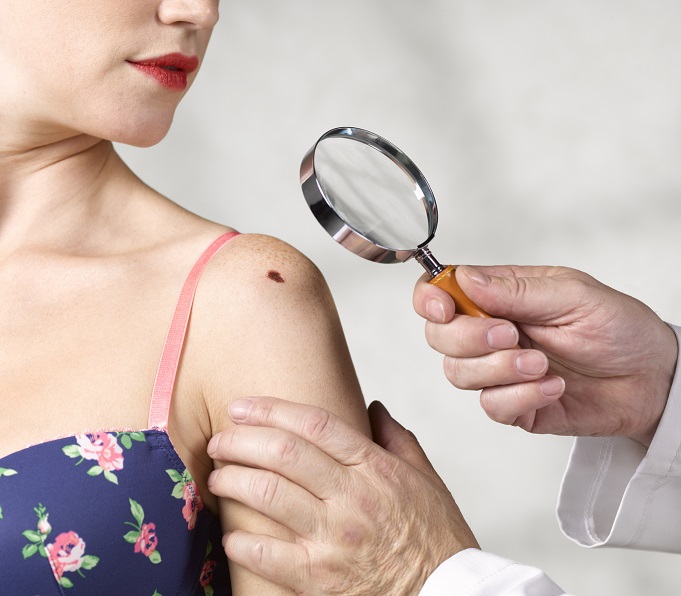It’s the time of year people want to be out and enjoy the sunshine, particularly after feeling confined due to the pandemic.
However, now is not the time to lapse in taking care of yourself and your skin when exposed to ultraviolet rays from the sun. The skin is the largest organ of the body and Jaime Mitchell, NP, at Carle Cancer Institute Urbana sees what can happen to patients who do not protect their skin and monitor changes in moles.
“UV rays cause damage to the skin and people with a lot of moles or fair complexions that burn easily are more susceptible to getting melanoma,” Mitchell said. Those with a family history of cancer or melanoma specifically need to be attentive as well to protecting their skin from the sun, she said.
Gardeners, farmers, construction workers and those enjoying the outdoor pool are among those particularly susceptible to overexposure from the UV rays. For sun protection, wear a hat, sunglasses and continue to reapply sunscreen with an SPF of 30 or more, Mitchell said. Avoid tanning beds and remind yourself the more exposure you have to UV rays, the more likely your skin will wrinkle as you age.
 Those with moles need to follow the A, B, C, D, E rules for monitoring your moles:
Those with moles need to follow the A, B, C, D, E rules for monitoring your moles:
A - Asymmetry - Can you visualize the mole folded equally in half like a round basketball?
B - Border - Is the border of the mole irregular or consistent in shape?
C - Color - Is the color varied within the mole?
D - Diameter - Is the mole larger than ¼ inch in diameter?
E - Evolving - Does the mole change in appearance over time?
Ask someone close to you to take a photo of your back. The image provides a baseline view should moles on your back change, she said.
“Once you realize you have a mole that looks unusual, have it checked. The deeper the melanoma gets the more likely it can spread to the lymph nodes. First consult with your provider who will determine if a trip to the Cancer Institute Urbana is needed,” Mitchell said. ”Early detection and action is so important to treating melanoma.”
At the Cancer Institute, punch biopsies are often used to determine the depth of the melanoma present. From there, the specialist can determine if the skin cancer has spread to the lymph nodes and lymph node biopsies are also available through the Cancer Institute.
With melanoma, the survival rate for stages 1 and 2 is 99%. Survival decreases to 66% if it spreads to the lymph nodes and those with stage 4 have only a 27% likelihood of surviving over five years, she said. There are no chemotherapies to treat melanoma, only immunotherapy.
To learn more about skin cancer, go to carle.org/skincancer.
However, now is not the time to lapse in taking care of yourself and your skin when exposed to ultraviolet rays from the sun. The skin is the largest organ of the body and Jaime Mitchell, NP, at Carle Cancer Institute Urbana sees what can happen to patients who do not protect their skin and monitor changes in moles.
“UV rays cause damage to the skin and people with a lot of moles or fair complexions that burn easily are more susceptible to getting melanoma,” Mitchell said. Those with a family history of cancer or melanoma specifically need to be attentive as well to protecting their skin from the sun, she said.
Gardeners, farmers, construction workers and those enjoying the outdoor pool are among those particularly susceptible to overexposure from the UV rays. For sun protection, wear a hat, sunglasses and continue to reapply sunscreen with an SPF of 30 or more, Mitchell said. Avoid tanning beds and remind yourself the more exposure you have to UV rays, the more likely your skin will wrinkle as you age.
 Those with moles need to follow the A, B, C, D, E rules for monitoring your moles:
Those with moles need to follow the A, B, C, D, E rules for monitoring your moles:A - Asymmetry - Can you visualize the mole folded equally in half like a round basketball?
B - Border - Is the border of the mole irregular or consistent in shape?
C - Color - Is the color varied within the mole?
D - Diameter - Is the mole larger than ¼ inch in diameter?
E - Evolving - Does the mole change in appearance over time?
Ask someone close to you to take a photo of your back. The image provides a baseline view should moles on your back change, she said.
“Once you realize you have a mole that looks unusual, have it checked. The deeper the melanoma gets the more likely it can spread to the lymph nodes. First consult with your provider who will determine if a trip to the Cancer Institute Urbana is needed,” Mitchell said. ”Early detection and action is so important to treating melanoma.”
At the Cancer Institute, punch biopsies are often used to determine the depth of the melanoma present. From there, the specialist can determine if the skin cancer has spread to the lymph nodes and lymph node biopsies are also available through the Cancer Institute.
With melanoma, the survival rate for stages 1 and 2 is 99%. Survival decreases to 66% if it spreads to the lymph nodes and those with stage 4 have only a 27% likelihood of surviving over five years, she said. There are no chemotherapies to treat melanoma, only immunotherapy.
To learn more about skin cancer, go to carle.org/skincancer.
Categories: Staying Healthy
